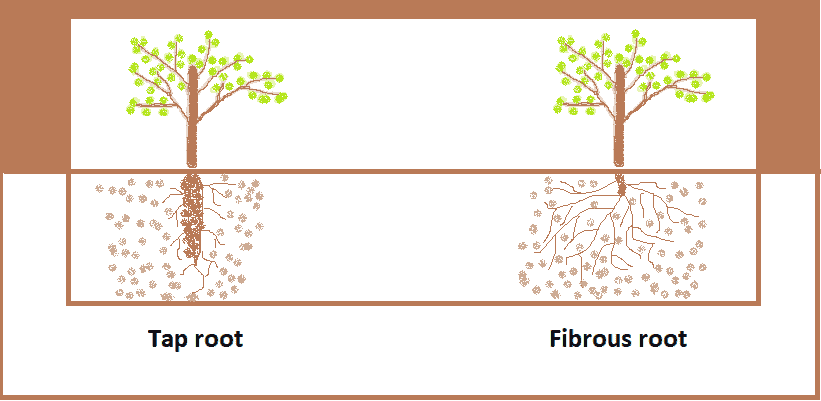Welcome back, friends. This is another post in the series of knowing the root systems. My previous post was Plants with fibrous roots. You can check it with the given link. Today we will discuss the Taproot system and some plants with taproots.
Without wasting any time, let’s start the discussion.

You should read the previous article on 10 Beautiful French Flowers, You should try growing
What is Tap Root?
The root develops from a germinating seed is the taproot. It has no initial branches. Latter on this root grows Thick and provides central support to the plant.
Taproot is the main root of the plant. In simple words, we can say that the root developed from seed is the taproot.
Technically a taproot is a central dominant root structure that supports plant growth. Fibrous roots generally grow from this main root.
Taproot supports continuous growth in the height of the plant. It seems very interesting as many of the plants having tap root systems are small bushes or shrubs. It is the beauty of nature. There are always some exceptions to explore.
Do you know?– Almost every plant growing from a seed develops a taproot system. Some continue to use and develop this root throughout their lives whereas others may divide this task in numerous adventitious or fibrous roots.

Also read: Are Rainbow Roses Real or Fake? Something to Know
How to Identify Tap Root in a Plant?
Identifying a taproot is not very difficult. Sometimes simple overlook is enough to find the taproot. Before proceeding, let us first understand- Why do we need to Identify taproot in a plant?
There are 2 main reasons for the question. First is the obvious one, We need to identify a taproot to study and observe its structure. The second reason is a more specific one. Generally, skilled Bonsai makers take care of this. They search for the main roots and prune it carefully. This is an important step in bonsai making but we are not going to discuss that.
Next how to identify taproots in any plant?- to identify taproot you should observe the base of the shoot. If there are few roots then check out for the thicker of them, it is the taproot. Else check the one that contains the maximum number of fibrous roots attached to it. Definitely this will be the taproot.
Hey! Be careful don’t waste time searching without knowing if the plant has any taproot or not. Sometimes you cannot distinguish the difference between taproot and fibrous root just by seeing it. SO be smart, make sure that the chosen plant must have one.
Types Of Tap Roots
Generally, the Taproot system doesn’t have any specific differentiation for types or variations. Instead, they have given names based on the shape they acquire on maturity. There are many significant differences observed in taproot throughout the globe. Still, there are only 3 prominent types of taproot according to shape.
- Conical root: As the name suggests this type of root has a significant conical shape. This is the most common type of taproot. This type of root has a wide top and tapering conical ends. Carrot is a common example of a conical root system.
- Fusiform root: These roots have a wider middle section and tapering top and bottom ends. You can think of it as a two-sided fusion of conical roots. A common example of the fusiform root is Radish.
- Napiform root: Widder top and pointed bottom ends is significant in Napiform root. It is a top like structure that is confined to smaller shape and space. Turnip is an example of Napiform roots.
100 Plants with Tap Root System
Taproot is very common in the plant kingdom. There are 1000 or even millions of plants having taproots. Here I have listed some very common plants having defined tap root systems. This list is just an example of plants that have well-defined taproots. Check out all of these.
You can buy the best quality plants on Amazon.
20 Common Plants with Tap Roots
- Beetroot
- Burdock
- Carrot
- Sugar beet
- Dandelion
- Parsley
- Parsnip
- Poppy mallow
- Radish
- Sagebrush
- Turnip
- Common milkweed
- Cannabis
- oaks
- Elms
- Pines
- Firs
- Mango
- Papaya
- Jackfruit

1-20: Commonly Known Taproot Plants
- Carrot (Daucus carota subsp. sativus)
- Type: Root vegetable
- Origin: Iran, Afghanistan
- Radish (Raphanus sativus)
- Type: Root vegetable
- Origin: Southeast Asia
- Beetroot (Beta vulgaris)
- Type: Root vegetable
- Origin: Mediterranean
- Turnip (Brassica rapa subsp. rapa)
- Type: Root vegetable
- Origin: Central and East Asia
- Parsley (Petroselinum crispum)
- Type: Herb
- Origin: Mediterranean region
- Dandelion (Taraxacum officinale)
- Type: Herbaceous perennial
- Origin: Eurasia
- Chicory (Cichorium intybus)
- Type: Herbaceous perennial
- Origin: Europe, North Africa, Western Asia
- Burdock (Arctium lappa)
- Type: Biennial plant
- Origin: Europe, Asia
- Parsley root (Petroselinum crispum var. tuberosum)
- Type: Root vegetable
- Origin: Mediterranean region
- Horseradish (Armoracia rusticana)
- Type: Perennial plant
- Origin: Southeastern Europe, Western Asia
- Parsnip (Pastinaca sativa)
- Type: Root vegetable
- Origin: Eurasia
- Salsify (Tragopogon porrifolius)
- Type: Biennial plant
- Origin: Mediterranean region
- Sugar beet (Beta vulgaris subsp. vulgaris)
- Type: Root crop
- Origin: Mediterranean
- Turnip-rooted chervil (Chaerophyllum bulbosum)
- Type: Root vegetable
- Origin: Central Europe, Caucasus
- Cassava (Manihot esculenta)
- Type: Root crop
- Origin: South America
- Bitter gourd (Momordica charantia)
- Type: Annual vine
- Origin: Tropical Africa
- Jicama (Pachyrhizus erosus)
- Type: Root vegetable
- Origin: Mexico, Central America
- Lettuce (Lactuca sativa)
- Type: Leafy vegetable
- Origin: Mediterranean, West Asia
- Yucca (Yucca spp.)
- Type: Perennial shrub
- Origin: North and Central America
- Cotton (Gossypium spp.)
- Type: Perennial shrub
- Origin: Tropics and subtropics worldwide
21-40: Leguminous Taproot Plants
- Alfalfa (Medicago sativa)
- Type: Perennial forage crop
- Origin: Central Asia
- Chickpea (Cicer arietinum)
- Type: Annual legume
- Origin: Middle East
- Lentil (Lens culinaris)
- Type: Annual legume
- Origin: Near East, Central Asia
- Peanut (Arachis hypogaea)
- Type: Annual legume
- Origin: South America
- Lupin (Lupinus spp.)
- Type: Perennial legume
- Origin: Mediterranean
- Fava bean (Vicia faba)
- Type: Annual legume
- Origin: Mediterranean
- Soybean (Glycine max)
- Type: Annual legume
- Origin: East Asia
- Pigeon pea (Cajanus cajan)
- Type: Perennial legume
- Origin: South Asia
- Cowpea (Vigna unguiculata)
- Type: Annual legume
- Origin: Africa
- Mung bean (Vigna radiata)
- Type: Annual legume
- Origin: South Asia
- Broad bean (Vicia faba)
- Type: Annual legume
- Origin: Mediterranean
- Black gram (Vigna mungo)
- Type: Annual legume
- Origin: South Asia
- Winged bean (Psophocarpus tetragonolobus)
- Type: Perennial legume
- Origin: New Guinea
- Velvet bean (Mucuna pruriens)
- Type: Annual legume
- Origin: Africa, Asia
- Guar (Cyamopsis tetragonoloba)
- Type: Annual legume
- Origin: India
- Tepary bean (Phaseolus acutifolius)
- Type: Annual legume
- Origin: Southwest United States, Mexico
- Common bean (Phaseolus vulgaris)
- Type: Annual legume
- Origin: Central and South America
- Lablab bean (Lablab purpureus)
- Type: Annual or perennial legume
- Origin: Africa
- Hyacinth bean (Lablab purpureus)
- Type: Annual or perennial legume
- Origin: Africa
- Pinto bean (Phaseolus vulgaris)
- Type: Annual legume
- Origin: Central America
41-60: Medicinal and Culinary Herbaceous Taproot Plants
- Echinacea (Echinacea purpurea)
- Type: Perennial herb
- Origin: North America
- Borage (Borago officinalis)
- Type: Annual herb
- Origin: Mediterranean region
- Angelica (Angelica archangelica)
- Type: Biennial herb
- Origin: Northern Europe
- Comfrey (Symphytum officinale)
- Type: Perennial herb
- Origin: Europe
- Valerian (Valeriana officinalis)
- Type: Perennial herb
- Origin: Europe, Asia
- Fennel (Foeniculum vulgare)
- Type: Perennial herb
- Origin: Mediterranean
- Lovage (Levisticum officinale)
- Type: Perennial herb
- Origin: Mediterranean
- Ginseng (Panax ginseng)
- Type: Perennial herb
- Origin: Northeast Asia
- Ashwagandha (Withania somnifera)
- Type: Perennial herb
- Origin: India, Middle East
- Burdock (Arctium lappa)
- Type: Biennial herb
- Origin: Europe, Asia
- Yellow Dock (Rumex crispus)
- Type: Perennial herb
- Origin: Europe, Western Asia
- Elecampane (Inula helenium)
- Type: Perennial herb
- Origin: Europe, Asia
- Ginger (Zingiber officinale)
- Type: Perennial herb
- Origin: Southeast Asia
- Turmeric (Curcuma longa)
- Type: Perennial herb
- Origin: South Asia
- Licorice (Glycyrrhiza glabra)
- Type: Perennial herb
- Origin: Mediterranean, Central Asia
- Yarrow (Achillea millefolium)
- Type: Perennial herb
- Origin: Northern Hemisphere
- Anise (Pimpinella anisum)
- Type: Annual herb
- Origin: Mediterranean, Southwest Asia
- Hyssop (Hyssopus officinalis)
- Type: Perennial herb
- Origin: Southern Europe, Middle East
- Chamomile (Matricaria chamomilla)
- Type: Annual herb
- Origin: Europe, Western Asia
- Mullein (Verbascum thapsus)
- Type: Biennial herb
- Origin: Europe, Asia
61-80: Trees and Shrubs with Taproots
- Oak (Quercus spp.)
- Type: Deciduous tree
- Origin: Northern Hemisphere
- Pine (Pinus spp.)
- Type: Coniferous tree
- Origin: Northern Hemisphere
- Maple (Acer spp.)
- Type: Deciduous tree
- Origin: Northern Hemisphere
- Cedar (Cedrus spp.)
- Type: Coniferous tree
- Origin: Mediterranean, Himalayas
- Walnut (Juglans spp.)
- Type: Deciduous tree
- Origin: North America, Europe, Asia
- Hickory (Carya spp.)
- Type: Deciduous tree
- Origin: North America, China
- Pecan (Carya illinoinensis)
- Type: Deciduous tree
- Origin: United States, Mexico
- Chestnut (Castanea spp.)
- Type: Deciduous tree
- Origin: Northern Hemisphere
- Eucalyptus (Eucalyptus spp.)
- Type: Evergreen tree
- Origin: Australia
- Baobab (Adansonia spp.)
- Type: Deciduous tree
- Origin: Africa, Madagascar, Australia
- Teak (Tectona grandis)
- Type: Deciduous tree
- Origin: South Asia, Southeast Asia
- Mahogany (Swietenia spp.)
- Type: Deciduous tree
- Origin: Tropical Americas
- Rosewood (Dalbergia spp.)
- Type: Deciduous tree
- Origin: Tropical regions worldwide
- Pomegranate (Punica granatum)
- Type: Deciduous shrub
- Origin: Iran, India
- Tamarind (Tamarindus indica)
- Type: Evergreen tree
- Origin: Africa
- Acacia (Acacia spp.)
- Type: Shrub/tree
- Origin: Australia, Africa
- Shea tree (Vitellaria paradoxa)
- Type: Deciduous tree
- Origin: Africa
- Mango (Mangifera indica)
- Type: Evergreen tree
- Origin: South Asia
- Neem (Azadirachta indica)
- Type: Evergreen tree
- Origin: Indian subcontinent
- Pistachio (Pistacia vera)
- Type: Deciduous tree
- Origin: Central Asia, Middle East
81-100: Flowering Plants and Ornamental Shrubs with Taproots
- Rose (Rosa spp.)
- Type: Perennial shrub
- Origin: Asia, Europe, North America
- Sunflower (Helianthus annuus)
- Type: Annual plant
- Origin: North America
- Marigold (Tagetes spp.)
- Type: Annual plant
- Origin: North and South America
- Zinnia (Zinnia spp.)
- Type: Annual plant
- Origin: Mexico, Southwest United States
- Dahlia (Dahlia spp.)
- Type: Perennial plant
- Origin: Mexico, Central America
- Peony (Paeonia spp.)
- Type: Perennial shrub
- Origin: Europe, Asia
- Clematis (Clematis spp.)
- Type: Perennial vine
- Origin: Europe, Asia
- Lavender (Lavandula spp.)
- Type: Perennial shrub
- Origin: Mediterranean
- Hibiscus (Hibiscus spp.)
- Type: Perennial shrub
- Origin: Tropical regions worldwide
- Jasmine (Jasminum spp.)
- Type: Perennial shrub
- Origin: Eurasia, Australasia, Oceania
- Bougainvillea (Bougainvillea spp.)
- Type: Perennial vine
- Origin: South America
- Hydrangea (Hydrangea spp.)
- Type: Perennial shrub
- Origin: Asia, Americas
- Gardenia (Gardenia jasminoides)
- Type: Evergreen shrub
- Origin: Asia
- Azalea (Rhododendron spp.)
- Type: Perennial shrub
- Origin: Asia, Europe, North America
- Camellia (Camellia spp.)
- Type: Evergreen shrub
- Origin: Asia
- Daisy (Bellis perennis)
- Type: Perennial plant
- Origin: Europe
- Begonia (Begonia spp.)
- Type: Perennial herbaceous plant
- Origin: Tropical regions worldwide
- Petunia (Petunia spp.)
- Type: Annual plant
- Origin: South America
- Snapdragon (Antirrhinum majus)
- Type: Perennial plant
- Origin: Mediterranean
- Foxglove (Digitalis purpurea)
- Type: Biennial or perennial plant
- Origin: Europe
Interesting Facts about plants with taproots
Do you Know?- Mangoes and papayas grown from seeds have a taproot. But if you buy one from a plant seller then it won’t have one. Sold plants only have fibrous roots because these are grafted or air layered plants.
Interestingly, These plants can develop main roots after several years of successful growth.
2) Turnip and Radish Look similar in structure but they have different root systems. Turnip has napiform roots whereas radish has fusiform roots.
Final Words
I hope this list of plants with taproots is useful to you. It is a basic information post. I know there are many other plants that have taproots. I have missed many but if you want, you can suggest to me some update on this list. Waiting for your precious comments and suggestion.
Stay Home stay safe and keep gardening.
Live the Green!
Credit: Wikipedia and all my readers.

I just watched the movie, Taproots with Van Heflin, and wanted a definition. When I discovered my favorite vegetable, a carrot, is a taproot I wanted to know what other ones are. That led me to you. And, strangely enough, just a couple of days ago I latched onto the idea of gardening on my balcony instead of just lamenting the fact I had no land to plant. Looks like I came to the right place for lots of information. I’m looking forward to learning more. The last time I gardened I was still a kid. In the “olden days”. Thanks for the info and in advance for the help.
Sincerely, Laura-Lee
BTW. It was a great movie. Much more complex than I expected although it had nothing to do with gardening. Just the Civil war between the states. 🤷♀️
Thank you so much!! I had to gain information about roots. And pls post fibrous root part also, I want to about that also
Regards,
Dipiksha
Hi Dipiksha, search for fibrous roots in the top right corner” search bar”. It has a list of plants with fibrous roots.